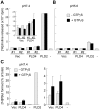Phospholipase D family member 4, a transmembrane glycoprotein with no phospholipase D activity, expression in spleen and early postnatal microglia
- PMID: 21085684
- PMCID: PMC2978679
- DOI: 10.1371/journal.pone.0013932
Phospholipase D family member 4, a transmembrane glycoprotein with no phospholipase D activity, expression in spleen and early postnatal microglia
Abstract
Background: Phospholipase D (PLD) catalyzes conversion of phosphatidylcholine into choline and phosphatidic acid, leading to a variety of intracellular signal transduction events. Two classical PLDs, PLD1 and PLD2, contain phosphatidylinositide-binding PX and PH domains and two conserved His-x-Lys-(x)(4)-Asp (HKD) motifs, which are critical for PLD activity. PLD4 officially belongs to the PLD family, because it possesses two HKD motifs. However, it lacks PX and PH domains and has a putative transmembrane domain instead. Nevertheless, little is known regarding expression, structure, and function of PLD4.
Methodology/principal findings: PLD4 was analyzed in terms of expression, structure, and function. Expression was analyzed in developing mouse brains and non-neuronal tissues using microarray, in situ hybridization, immunohistochemistry, and immunocytochemistry. Structure was evaluated using bioinformatics analysis of protein domains, biochemical analyses of transmembrane property, and enzymatic deglycosylation. PLD activity was examined by choline release and transphosphatidylation assays. Results demonstrated low to modest, but characteristic, PLD4 mRNA expression in a subset of cells preferentially localized around white matter regions, including the corpus callosum and cerebellar white matter, during the first postnatal week. These PLD4 mRNA-expressing cells were identified as Iba1-positive microglia. In non-neuronal tissues, PLD4 mRNA expression was widespread, but predominantly distributed in the spleen. Intense PLD4 expression was detected around the marginal zone of the splenic red pulp, and splenic PLD4 protein recovered from subcellular membrane fractions was highly N-glycosylated. PLD4 was heterologously expressed in cell lines and localized in the endoplasmic reticulum and Golgi apparatus. Moreover, heterologously expressed PLD4 proteins did not exhibit PLD enzymatic activity.
Conclusions/significance: Results showed that PLD4 is a non-PLD, HKD motif-carrying, transmembrane glycoprotein localized in the endoplasmic reticulum and Golgi apparatus. The spatiotemporally restricted expression patterns suggested that PLD4 might play a role in common function(s) among microglia during early postnatal brain development and splenic marginal zone cells.
Conflict of interest statement
Figures








Similar articles
-
PLD$ is involved in phagocytosis of microglia: expression and localization changes of PLD4 are correlated with activation state of microglia.PLoS One. 2011;6(11):e27544. doi: 10.1371/journal.pone.0027544. Epub 2011 Nov 15. PLoS One. 2011. PMID: 22102906 Free PMC article.
-
A transmembrane phospholipase D in Phytophthora; a novel PLD subfamily.Gene. 2005 May 9;350(2):173-82. doi: 10.1016/j.gene.2005.02.012. Epub 2005 Apr 9. Gene. 2005. PMID: 15826868
-
Phosphatidylinositol (3,4,5)-trisphosphate specifically interacts with the phox homology domain of phospholipase D1 and stimulates its activity.J Cell Sci. 2005 Oct 1;118(Pt 19):4405-13. doi: 10.1242/jcs.02564. J Cell Sci. 2005. PMID: 16179605
-
The exquisite regulation of PLD2 by a wealth of interacting proteins: S6K, Grb2, Sos, WASp and Rac2 (and a surprise discovery: PLD2 is a GEF).Cell Signal. 2011 Dec;23(12):1885-95. doi: 10.1016/j.cellsig.2011.06.017. Epub 2011 Jun 29. Cell Signal. 2011. PMID: 21740967 Free PMC article. Review.
-
Phospholipase D as a catalyst: application in phospholipid synthesis, molecular structure and protein engineering.J Biosci Bioeng. 2013 Sep;116(3):271-80. doi: 10.1016/j.jbiosc.2013.03.008. Epub 2013 Apr 29. J Biosci Bioeng. 2013. PMID: 23639419 Review.
Cited by
-
The Concise Guide to PHARMACOLOGY 2013/14: enzymes.Br J Pharmacol. 2013 Dec;170(8):1797-867. doi: 10.1111/bph.12451. Br J Pharmacol. 2013. PMID: 24528243 Free PMC article.
-
Targeting of Phospholipase D1 Ameliorates Collagen-Induced Arthritis via Modulation of Treg and Th17 Cell Imbalance and Suppression of Osteoclastogenesis.Int J Mol Sci. 2020 May 2;21(9):3230. doi: 10.3390/ijms21093230. Int J Mol Sci. 2020. PMID: 32370217 Free PMC article.
-
Mechanism of enzymatic reaction and protein-protein interactions of PLD from a 3D structural model.Cell Signal. 2015 Jan;27(1):69-81. doi: 10.1016/j.cellsig.2014.09.008. Epub 2014 Oct 12. Cell Signal. 2015. PMID: 25308783 Free PMC article.
-
Luminal Phospholipase D Attacks Bacterial Membranes in Dictyostelium discoideum Phagosomes.Mol Microbiol. 2025 Jul;124(1):54-65. doi: 10.1111/mmi.15367. Epub 2025 May 4. Mol Microbiol. 2025. PMID: 40320828 Free PMC article.
-
Crystal structure of Alzheimer's disease phospholipase D3 provides a molecular basis for understanding its normal and pathological functions.FEBS J. 2024 Dec;291(24):5398-5419. doi: 10.1111/febs.17277. Epub 2024 Sep 26. FEBS J. 2024. PMID: 39325669 Free PMC article.
References
-
- Exton JH. Regulation of phospholipase D. FEBS Lett. 2002;531:58–61. - PubMed
-
- Aoki J, Inoue A, Okudaira S. Two pathways for lysophosphatidic acid production. Biochim Biophys Acta. 2008;1781:513–518. - PubMed
-
- Roth MG. Molecular mechanisms of PLD function in membrane traffic. Traffic. 2008;9:1233–1239. - PubMed
Publication types
MeSH terms
Substances
LinkOut - more resources
Full Text Sources
Other Literature Sources
Molecular Biology Databases
Research Materials

